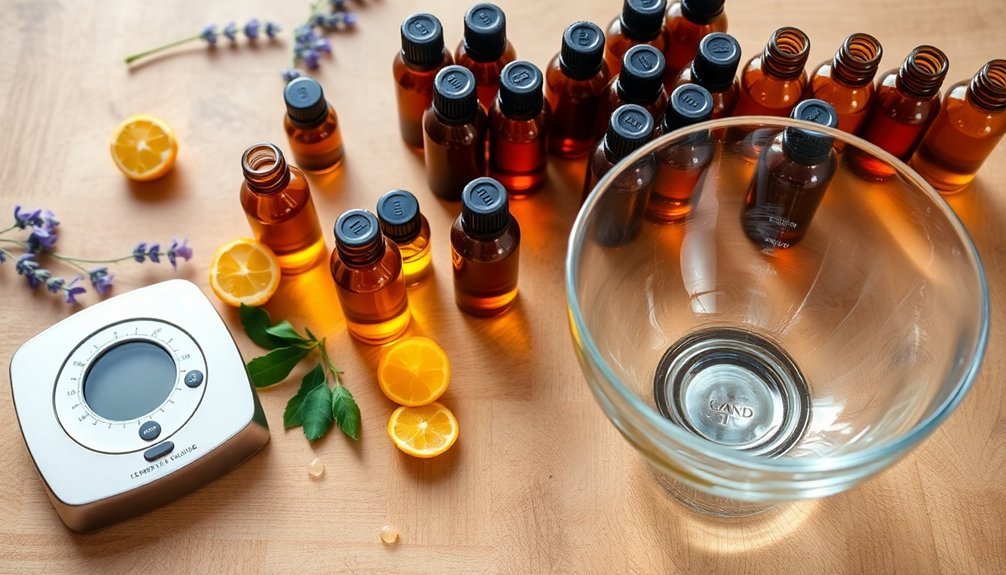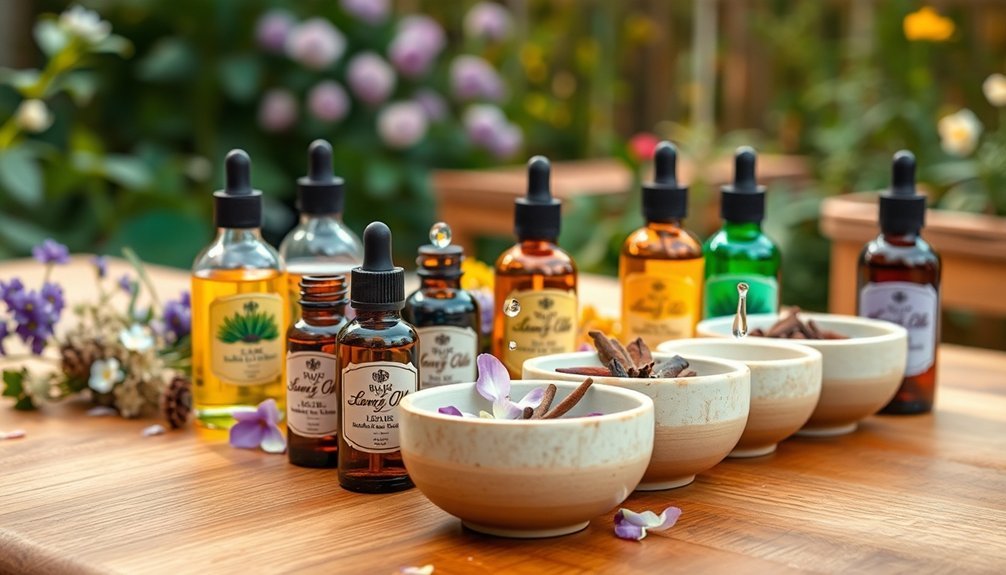To create your own natural perfume, you'll need to master the essential oil note categories: top (first impressions), middle (heart), and base (depth). Start with a proven 30:50:20 ratio of top:middle:base notes, using about 100 drops total. Mix your chosen oils in amber bottles, letting them mature for several days to achieve proper integration. Consider factors like aroma strength and evaporation rates when adjusting your blend. The journey to perfume mastery unfolds with each new combination you explore.
Understanding Essential Oil Notes and Their Roles

When creating natural perfumes, understanding essential oil notes is essential for achieving a well-balanced fragrance.
You'll encounter three distinct note categories: top, middle, and base. Each plays a significant role in your perfume's development.
Top notes create your first impression with sharp, fresh scents like citrus and herbs, lasting about 30 minutes.
Middle notes form the heart of your blend, offering warm, rounded aromas like geranium and ylang-ylang that persist for 2-3 hours.
Base notes, including sandalwood and patchouli, provide depth and longevity to your creation.
These notes work together like a musical composition, following concepts developed by Septimus Piesse in the nineteenth century.
While some oils can overlap between categories, you'll need to balance all three to create a harmonious fragrance that unfolds beautifully over time.
Use a blending wheel to guide your combinations.
Perfect Ratios for Natural Perfume Blending
Building on your knowledge of essential oil notes, mastering the right blend ratios will elevate your natural perfume creation from good to exceptional.
Start with the beginner's ratio of 30% top notes, 50% middle notes, and 20% base notes, then experiment with variations like 1:1:1 or 3:2:1 as you gain confidence.
Remember that aroma strength differs from evaporation rate. Steam distillation techniques, perfected by Islamic cultures, revolutionized how we extract and blend essential oils today. You'll need to adjust your ratios when working with powerful scents like chamomile, which can easily overpower milder oils like lavender.
For a practical 100-drop formula, you might use 30 drops of top notes, 50 drops of middle notes, and 20 drops of base notes.
Let your blend rest for several days to allow the chemicals to interact properly.
Test your creations on perfume strips or cotton balls to find your perfect balance.
Creating Your Signature Scent Step-by-Step

Creating your signature scent begins with a thoughtful selection of essential oils that reflect your personality and desired emotional impact. Choose three to five oils from complementary scent families, considering their roles as top, middle, and base notes.
Start with a proven ratio like 3:2:1 (top:middle:base) and adjust as needed. Mix your chosen oils carefully, remembering their potency. Test the blend on your skin and observe how it develops over several hours. You'll notice the top notes fade first, revealing the heart of your perfume, before settling into the base notes.
Let your blend mature for at least a month to allow the scents to integrate fully. Document your formula carefully, and don't forget to perform a patch test before regular use. Using quality ingredients like sweet almond carrier oil will help create a long-lasting, skin-safe fragrance.
Consider creating seasonal variations of your signature scent.
Essential Tools and Materials for DIY Perfumery
Successful DIY perfumery requires a well-equipped workspace with essential tools and quality materials.
You'll need precise measurement tools like a digital scale with 0.01g precision and various pipettes for accurate ingredient portions. Stock your workspace with conical flasks, beakers, and amber bottles for mixing and storing your creations.
For your raw materials, gather natural ingredients such as scented leaves, flowers, and essential oils in different notes – base, middle, and top.
Don't forget important bases and fixatives like perfumer's alcohol and orris root. Safety equipment, including gloves and proper ventilation, is non-negotiable when working with these materials.
Keep your workspace organized with proper storage containers, labels, and documentation tools to track your formulas and experiments.
A stainless steel tray will protect your surface during the mixing process.
Mastering the Art of Scent Layering

While many novice perfumers focus solely on individual scents, mastering the art of scent layering opens up endless possibilities for creating unique fragrances. You'll want to start with clean, moisturized skin and understand how different notes interact. Apply stronger base notes first, then layer lighter scents on top to create a harmonious blend.
| Layer Type | Best Practice |
|---|---|
| Top Notes | Apply last, using citrus or light florals |
| Middle Notes | Wait 30 seconds after base notes |
| Base Notes | Start with these as your foundation |
| Complementary Products | Use matching body lotions or oils |
Remember to let each layer dry completely before adding the next. You can experiment with direct layering or mixing on separate skin areas. Document your successful combinations to recreate your favorite blends in the future.
Frequently Asked Questions
How Long Does Homemade Natural Perfume Typically Last Before Going Bad?
Your homemade natural perfume will typically last 1-2 years if it's citrus-based, or up to 8 years for woody scents. You'll need to store it properly in a cool, dark place to maximize longevity.
Can I Mix Synthetic Fragrances With Essential Oils in Natural Perfumes?
Yes, you can mix synthetic fragrances with essential oils. You'll get better stability, longer-lasting scents, and more creative options. Just guarantee proper dilution ratios and use high-quality ingredients for safe, effective blending.
Why Does My Perfume Smell Different on My Friend Than Me?
Your unique body chemistry, skin type, and diet make perfumes smell different on you compared to your friend. Your pH levels, natural oils, and even the environment affect how fragrances develop on skin.
What's the Best Season or Temperature to Blend Natural Perfumes?
You'll get the best results blending natural perfumes in moderate temperatures (65-75°F) during spring or fall. Cool, dry conditions help you accurately assess scents while avoiding the extreme effects of summer heat or winter cold.
Can Pregnant Women Safely Wear Natural Essential Oil Perfumes?
You can safely wear natural perfumes while pregnant, but stick to pregnancy-safe oils like lavender, chamomile, and diluted citrus. Always consult your healthcare provider and avoid oils that stimulate uterine contractions.
In Summary
You're now equipped with the essentials of natural perfume blending. Start with the 30-50-20 ratio (base, middle, top notes), and don't be afraid to adjust it based on your preferences. Remember to keep detailed notes of your successful blends, and let each creation rest for at least 48 hours before making final adjustments. With practice and patience, you'll develop your unique signature scents that rival commercial fragrances.





Leave a Reply